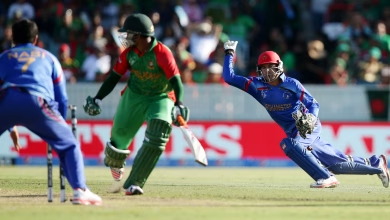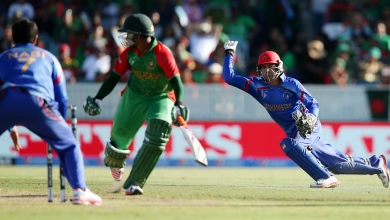“The Most Shocking Umpire Decision in Cricket History !
he Most Shocking Umpire Decision in Cricket History: A Deep Dive into Controversy
Cricket, often referred to as the “gentleman’s game,” is renowned for its tradition, sportsmanship, and high level of discipline. However, throughout its rich history, there have been several controversial moments involving umpire decisions that have left fans, players, and commentators alike stunned. Some of these decisions have caused widespread debate, while others have had a profound impact on the outcome of matches. Among all the contentious calls in the history of cricket, one stands out as arguably the most shocking umpire decision: the infamous “Steve Bucknor and the 2008 India-Australia Test series”.
This decision, involving a combination of poor judgment, inconsistent rulings, and an intense on-field rivalry, changed the way people viewed umpiring in cricket. This article will delve into the specifics of the decision, the aftermath, and its lasting impact on the sport.
The Background: The India-Australia 2008 Test Series
The incident occurred during the 2008 Border-Gavaskar Trophy, a Test series between India and Australia, two of the most dominant cricketing nations at the time. This series was filled with high stakes, as India was coming off a historic Test series win over England, and Australia, under the leadership of Ricky Ponting, was still considered the world’s number one Test team.
One of the key points of tension was the Sydney Test held at the Sydney Cricket Ground (SCG) in January 2008. The match saw several controversies that would go on to define the series, but the most shocking incident came on Day 3, when Indian spinner Harbhajan Singh was involved in a crucial moment that not only sparked a war of words but also raised questions about umpire decisions.
The Shocking Incident: Harbhajan Singh and the “Monkeygate” Controversy
During the third day of the match, Australian batsman Matthew Hayden was facing Harbhajan Singh. Harbhajan bowled a delivery that appeared to spin away from the right-handed Hayden, who was playing forward. Hayden, in an attempt to defend the ball, missed, and it appeared to have brushed his bat. Australian wicketkeeper Adam Gilchrist took the catch and immediately appealed for the dismissal.
The on-field umpires at the time, Steve Bucknor and Mark Benson, decided to consult the third umpire, Simon Taufel. The TV replays were inconclusive, but the third umpire, after some deliberation, decided that there was enough evidence to overturn the original decision. The result: Harbhajan Singh was given out. The cricketing world was left stunned.
However, the real controversy did not lie in the dismissal itself but in the handling of the situation and the shocking aftermath. Harbhajan Singh denied the charge of having “mocked” Matthew Hayden and claimed that no such incident took place. Following the match, there was a subsequent investigation into the alleged racist remark, leading to further scrutiny of the entire incident.
What made this umpire’s decision particularly shocking was not just the dismissal itself but the larger context that followed:
Racial Allegations: The umpire’s call came after allegations that Harbhajan had called Hayden a “monkey,” which was considered an ethnic slur. This led to the media dubbing the incident as “Monkeygate.” While the charge was eventually dropped, the damage had already been done.
Inconsistent Rulings: During the same match, several other decisions by the umpires, particularly Steve Bucknor, were deemed to be inconsistent. Bucknor, who had a long and respected career in international cricket, was criticized for not being up to par in his decision-making, with some claiming that he had been influenced by the intensity of the match.
Lack of Conclusive Evidence: The decision was also controversial because there was no definitive evidence to support the claim. The ball had not been conclusively shown to have hit the bat, and the third umpire’s decision was based on inconclusive visual evidence, a key factor that led to the uproar.
The Aftermath: A Series of Shocks and Fallouts
The aftermath of the shocking umpire decision was filled with multiple layers of controversy. While Harbhajan Singh’s suspension was overturned by the International Cricket Council (ICC) after a full hearing, the umpire’s decision had already caused significant damage.
The Impact on the Series: Australia eventually won the Sydney Test, but the focus of the match was diverted from the cricket itself to the ongoing feud between the two teams. India’s cricketers were clearly agitated by what they felt was unjust treatment by the umpires, and the decision created a hostile atmosphere that marred the remainder of the series.
The End of Steve Bucknor’s Umpiring Career: Perhaps the most significant fallout from the incident was the subsequent decision to remove Steve Bucknor from officiating in the remainder of the series. After the shocking decisions during the Sydney Test, India’s players, led by Anil Kumble, expressed their dissatisfaction with Bucknor’s performance. The decision to send him home was a clear message from the cricketing world that umpiring decisions had to be of the highest standards, especially in high-profile matches.
The ICC Review and Reforms: Following the controversy, the ICC reviewed the incident and, as part of the broader fallout, decided to implement several reforms to improve the standards of umpiring. This led to the introduction of Umpire Decision Review System (UDRS), which allows teams to challenge on-field decisions using technology like Hawk-Eye and ball-tracking. This system, though initially controversial, was a direct result of the Harbhajan Singh incident and the broader push for greater accountability in umpiring.
Harbhajan Singh’s Legacy: The incident cast a long shadow over Harbhajan Singh’s career. Although the suspension was lifted and the allegations cleared, the “Monkeygate” controversy became one of the defining moments of his career. In the years that followed, Harbhajan would occasionally reference the incident in interviews, noting how it affected him personally and professionally.
The Larger Impact: Umpire Decision-Making in Cricket
The Harbhajan Singh “Monkeygate” controversy had a profound impact on the way umpires make decisions in modern-day cricket. This incident led to several key changes in the sport’s governing structure and the use of technology:
Technological Reforms: The introduction of the UDRS helped reduce the number of shocking and incorrect umpire decisions. With technology now playing an integral role, players have more confidence that a decision will be accurate, reducing the emotional intensity of the game.
Scrutiny of Umpires: Umpires, who were once viewed as unquestionable authority figures, now find themselves under the microscope. With the advent of television coverage and the UDRS, their decisions are often analyzed and criticized in real-time. While this has improved accountability, it has also brought about an increased pressure on match officials to get decisions right.
Changes in the Role of the Third Umpire: The third umpire’s role has become even more critical post-2008, with more emphasis on the correct use of technology. The “Sydney Test” incident revealed the flaws in the initial use of the third umpire, prompting improvements in its operation and decision-making protocols.
A Shift in Player-Umpire Relations: The tensions between the players and umpires have evolved since the controversy, with both sides being more aware of their respective responsibilities. Player-umpire relations, though still tense at times, have become more professional, and both parties work towards maintaining respect and discipline on the field.
Conclusion: A Moment that Defined Cricket
The Steve Bucknor decision in the 2008 Sydney Test between India and Australia remains one of the most shocking umpire decisions in cricket history. The combination of unclear visual evidence, racial allegations, and inconsistent rulings on the field forever changed the way cricket is played and umpired. It highlighted the need for technological advancements in decision-making and the importance of fairness and accuracy in high-stakes cricket matches.
While the controversy of “Monkeygate” eventually faded into the past, it serves as a reminder of how crucial umpire decisions are in shaping the outcome of matches. Today, cricket is a game that continues to evolve, driven in part by the lessons learned from such shocking incidents.


